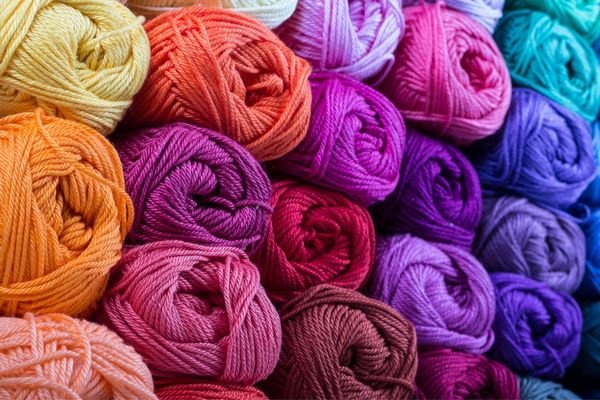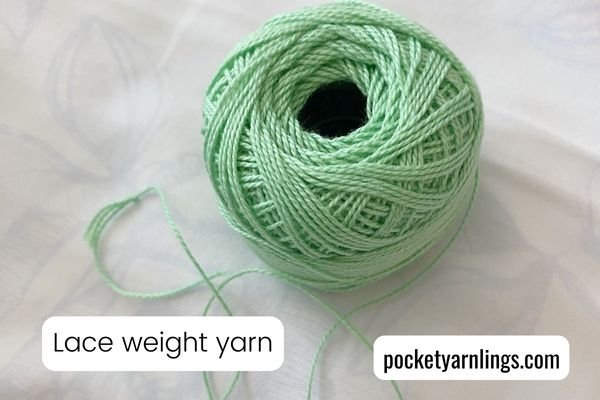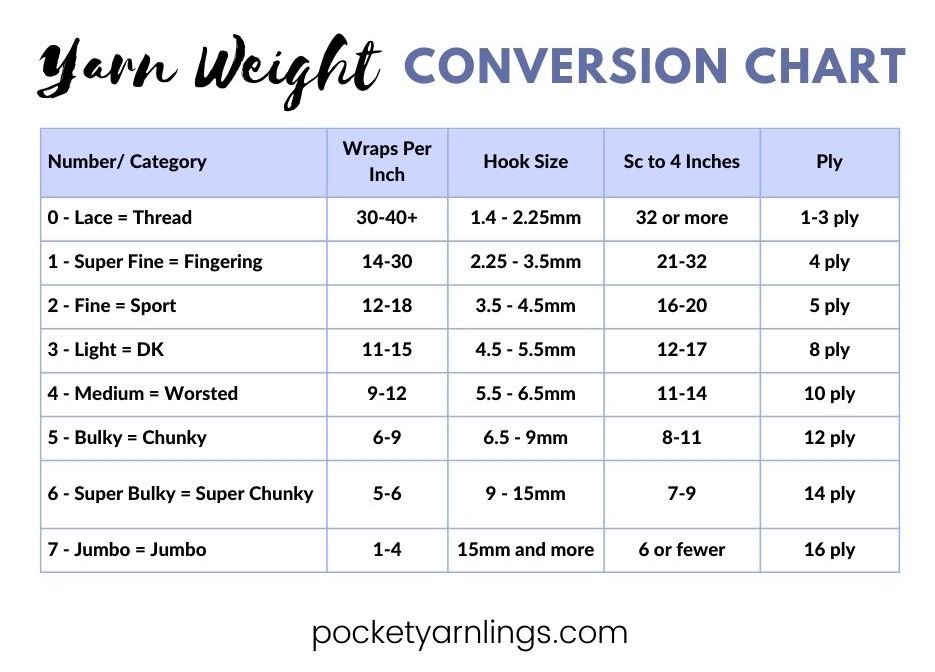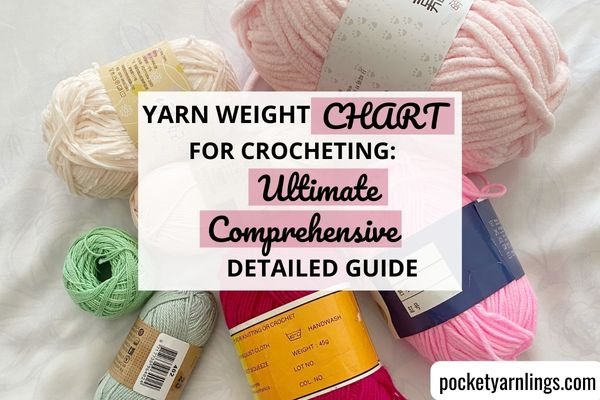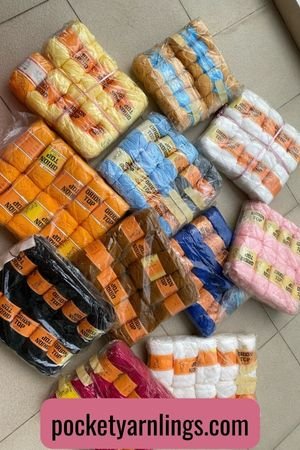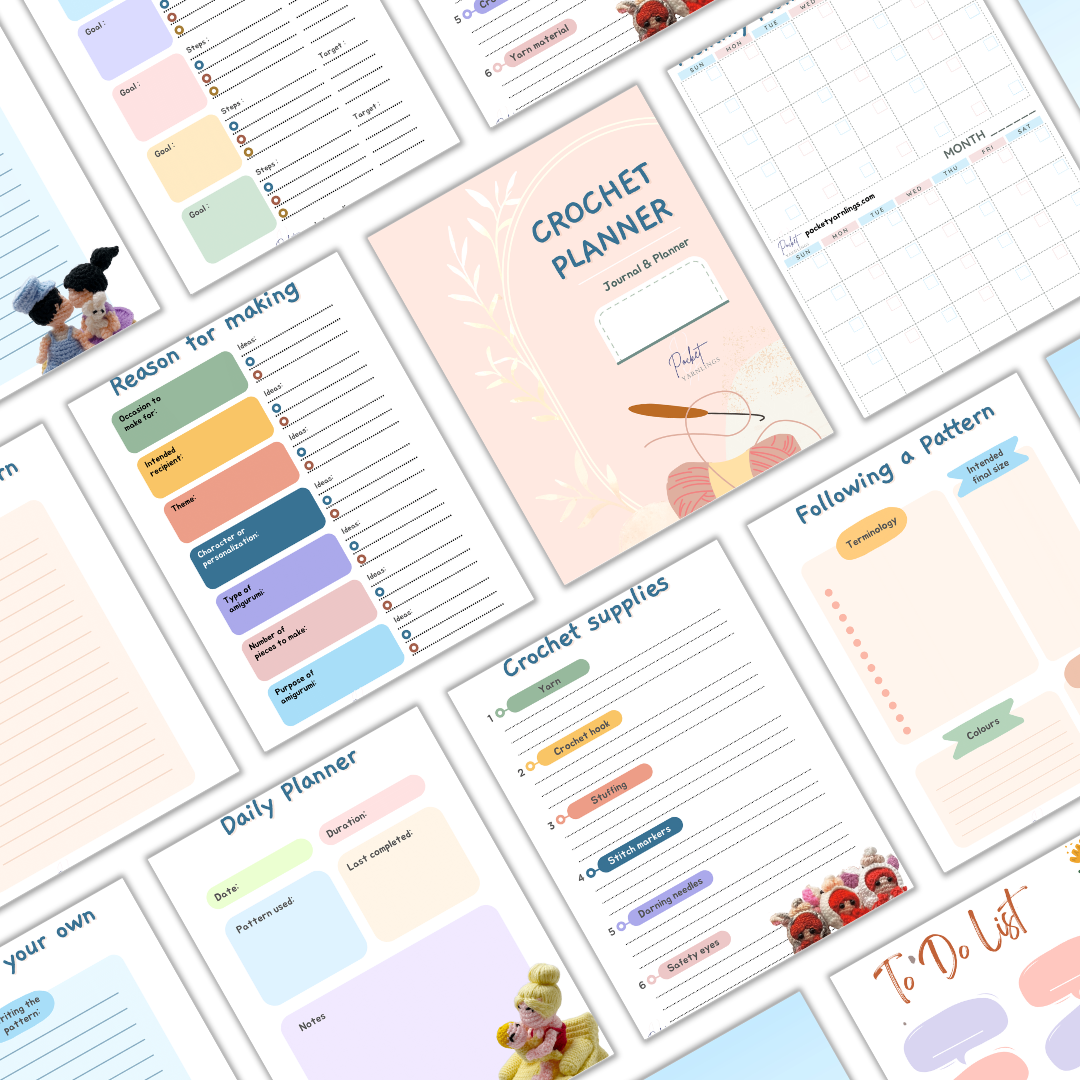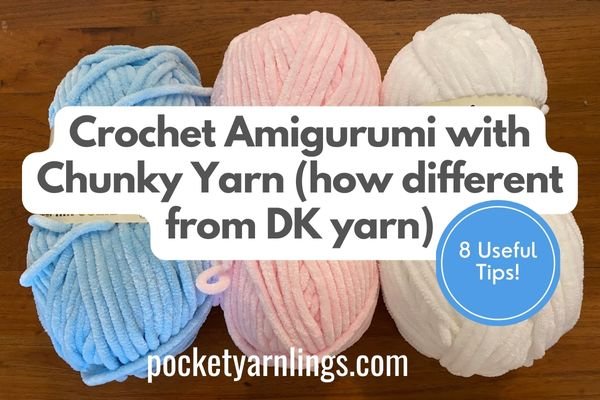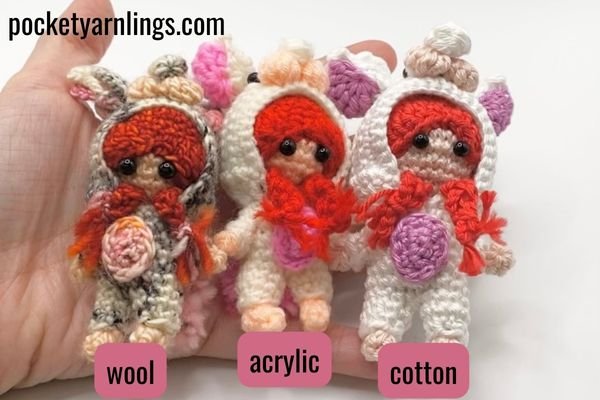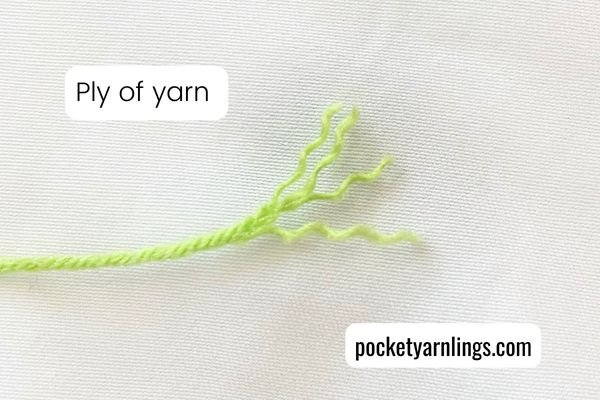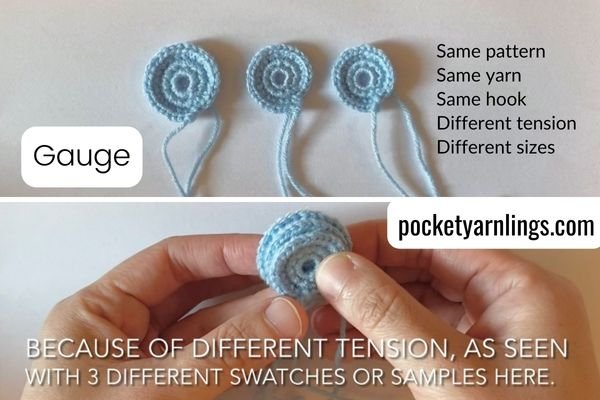How Many Yards Are in a Skein of Yarn? A Detailed Guide
Are you new to the world of crocheting and wondering how many yards are in a skein of yarn? Or maybe you're an experienced crocheter who's always wondered about this question but never found a clear answer. Whatever the case may be, understanding the yardage of a skein of yarn is essential for planning out your crocheting projects. This has confused me before which is the reason why I decided to pen this down for my own future reference as well!
Table of Contents Show
There are affiliate links in this post. We will receive a commission if you make a purchase through our affiliate link at no extra cost to you.
Definitions of Yarn Measurements
Let us talk about some definitions first of yarn measurements, so that it is easier to understand the subsequent parts about yard considerations for your yarn skeins. Here we will talk about skein, weight, weight category, skein weight and yardage.
What is a skein of yarn?
A skein is a term used to describe a length of yarn that is loosely wound and often twisted into a cylindrical shape. Skeins are a common form in which yarn is sold. Yarn manufacturers wind the yarn into skeins for ease of handling, storage, and presentation to consumers.
Skeins can vary in size, weight, and shape, and they typically have a centre-pull strand and a side-pull strand, both of which can be easily pulled from the skein while crocheting. They are different from balls, hanks and cakes of yarn.
Why is it called a skein?
The term "skein" comes from the Old Norse word "skein" or "skeið," which means "a length." The word has been used historically to refer to a length of thread or yarn. In the context of yarn crafting, a skein is a loosely wound bundle of yarn, typically twisted into a cylindrical shape. The name likely reflects the historical use of the term to describe a length of yarn or thread that can be easily measured and managed for various textile activities.
What is the difference between skein and yarn?
The terms "skein" and "yarn" refer to different aspects of the yarn used in crocheting, knitting, and other textile crafts. "Yarn" is the general term for a continuous strand of fibres used in textiles. Yarn can come in various forms, such as skeins, balls, hanks, or cones. A "skein" is a specific way of presenting yarn. It is a loosely wound bundle of yarn, often twisted into a cylindrical shape.
What is the weight of a yarn?
This can be confusing for beginner crocheters because the term "weight" in the context of yarn primarily refers to the thickness or diameter of the yarn strand, not its physical mass. Yarn weight categories, such as lace, fingering, worsted, provide a standardized way to communicate the thickness of the yarn. On the other hand, skein weight specifically denotes the physical mass or quantity of yarn in a skein, typically measured in grams or ounces.
While yarn weight categories help crafters choose the appropriate thickness for their projects, skein weight informs them about the total amount of yarn they are purchasing. Understanding both aspects of "weight" is crucial for beginner crocheters to select the right yarn for their creations and plan their projects effectively.
What is the weight category of a yarn?
Yarn weight categories are used to classify yarn based on thickness, and they range from lace weight (very thin) to super bulky weight (very thick). The standard yarn weight categories include:
Lace: Very thin yarn
Fingering (Sock): Fine yarn
Sport: Light weight
Worsted (Medium): Medium weight
Bulky: Heavy weight
Super Bulky: Very heavy/thick yarn
It's important to note that the weight classification doesn't directly indicate the physical mass or heaviness of the yarn skein; rather, it describes the yarn's thickness and is crucial for selecting an appropriate yarn for a specific pattern or project.
Learn more about yarn weight categories in this article “Yarn Weight Chart for Crocheting: Ultimate Comprehensive Detailed Guide”.
What is skein weight?
Skein weight typically refers to the amount of yarn in a skein, measured in units such as grams or ounces. It indicates the physical mass or weight of the yarn included in a single skein. For example, a skein might be labelled as a 100-gram skein or a 4-ounce skein.
This information is useful for crafters to estimate how much yarn they have for a particular project and to ensure they have enough yarn to complete their desired item. It's distinct from the "yarn weight" classification, which refers to the thickness or diameter of the yarn strand, as discussed in the previous response.
What does 100g skein mean?
A "100g skein" refers to a skein of yarn that weighs 100 grams. The number "100g" indicates the weight of the yarn in grams. Yarn is often sold in skeins with a specified weight, and the weight is usually measured in grams or ounces. In this case, the skein contains 100 grams of yarn.
The weight of the skein can impact the length of the yarn (yardage or meters), thickness (yarn weight category), and the amount needed for a particular project. Often for yarn choices to crochet amigurumi, because multiple colours are involved and in small quantity, sometimes the skein weight is only 25gm or 50gm.
What is yardage of yarn?
Yardage is also known as yard count or length and refers to the total length of yarn in yards or meters that is present in a skein or ball. It indicates how much yarn is available in a specific skein.
Yardage is important for estimating how much yarn you will need for a particular project and for calculating yardage requirements when substituting yarn for a pattern. It helps ensure that you have enough yarn to complete your project without running out.
The yardage can vary between skeins, and yarn labels often provide this information to assist crafters in estimating how much yarn they'll need for their crocheting projects.
The yarn label might display either the total yardage of the skein or yards per 100 grams. For instance, you may find an unusual measurement like 362 yards in 140 grams on the label, signifying that a single skein weighing 140 grams contains 362 yards of yarn.
Skein Measurements
Skein measurements typically include information about the weight (in grams or ounces) and length (in yards or metres) of the yarn. It's important to check these measurements on yarn labels to ensure they align with the requirements of the intended project.
Skein Yardage
When it comes to buying yarn, it's important to understand the different measurements used to describe it. One common measurement is yards per skein.
A skein is a length of yarn wound into a loose, oblong shape. The number of yards in a skein can vary depending on the weight and thickness of the yarn. For example, a skein of lace weight yarn may have 400 yards, while a skein of bulky weight yarn may only have 100 yards.
It's important to note that these are general guidelines and may vary depending on the brand and specific type of yarn. Always check the label for the exact yardage per skein.
Skein Weight
Also, when it comes to buying yarn, it's important to know the standard sizes of skeins. This information can help you determine how much yarn you need for your project and compare prices between different brands.
The most common skein sizes are 50g, 100g, and 200g. However, some brands may offer smaller or larger skeins. It's important to check the label for the weight of the skein and the yardage.
Keep in mind that the yardage can vary depending on the weight and thickness of the yarn. For example, a bulky weight yarn may have fewer yards per skein than a fingering weight yarn of the same weight, say a 100g skein.
It's also important to note that some yarns may be sold in balls or hanks instead of skeins. These may have different yardage and weight measurements, so be sure to check the label before purchasing.
Comparing Yarn Weight, Yardage per Skein and Weight per Skein
The following table shows the corresponding yarn weight categories against yardage per skein and physical weight per skein:
Please note that these are general ranges, and actual specifications can vary between different yarn brands and compositions. Always refer to the yarn label for accurate information. This table is meant for general comparison only.
You can see from the above table that for lighter weight yarn, the yardage is generally longer per skein, but the skein physical weight tend to be smaller as well. On the other hand, for bulky yarn, the yardage is shorter per skein within a general standard weight of 100 grams.
Calculating Yards in a Skein
Skeins of yarn come in different weights and sizes, and it's important to know how many yards are in a skein to determine how much you'll need for your project.
To calculate the yards in a skein, you need to check the yarn label. The label usually provides information on the total yardage for the entire skein. If the label doesn't explicitly state the total yardage, it might include information like "Yards per 100g" or similar.
In that case, you can use the weight of the skein and the given yards per weight to estimate the total yardage. For example, if it says "200 yards per 100g," a 200g skein would likely have around 400 yards. Always refer to the information provided on the yarn label for accurate details.
How do you calculate how much yarn is left in a skein?
This is important because you will have a lot of leftover yarn from previous projects and you will not know the yardage left because it will be much less than what is specified on the yarn label. You can use the following steps to determine the remaining yardage.
To calculate how much yarn is left in a skein, follow these steps:
Initial Weight: Start by noting the initial weight of the skein. This information is usually provided on the yarn label.
Weight Used: Track how much yarn you've used for your project. This can be done by weighing the project periodically or by estimating based on the yarn weight used per row or section.
Calculate Remaining Weight: Subtract the weight used from the initial weight to find the remaining weight of the yarn. Alternatively, you could just weigh the remaining unused yarn in the skein.
Yardage Calculation: If the yarn label provides information on the yardage per gram or ounce, you can estimate the remaining yardage by the following equation:
[Remaining Yardage = Remaining Weight x (Yardage Per Skein / Weight Per Skein)]
Let us go through an example:
Say the yarn label says 200 yards per 100gm of skein of yarn, which is for 1 skein of that particular yarn.
So (Yardage Per Skein / Weight Per Skein) = 200/100
You have used up say 65gm of yarn and when you weigh the remaining yarn, there is only 35gm left.
So Remaining Weight = 35gm
With the above measurements, then the final equation for remaining yardage should be the following:
Remaining Yardage = Remaining Weight x (Yardage Per Skein/ Weight Per Skein)
= 35 x 200/100
= 70 yards
So you have 70 yards of yarn left!
Remember to pin the image below to Pinterest if you found this article useful!
Free Crochet Planner Journal!
Click here to grab this 20-paged workbook and checklists that will help organize your creativity before you even start on your next crochet project! Or click on image on the left.
Factors Affecting Yardage
When it comes to determining how many yards are in a skein of yarn, there are several factors to consider. Here are some of the most important factors that can affect yardage:
1. Yarn Weight
The weight of the yarn is one of the most important factors that determine the yardage of a skein. Generally, the heavier the yarn, the fewer yards you will get in a skein. For example, a bulky weight yarn may only have around 100 yards per skein, while a fingering weight yarn could have over 400 yards per skein.
2. Fibre Content
The type of fibre used in the yarn can also affect the yardage. Natural fibres like wool, alpaca, and cotton tend to have more yardage than synthetic fibres like acrylic or nylon. This is because natural fibres are usually lighter in weight and can be spun thinner than synthetic fibres.
3. Ply
The number of plies in a yarn can also affect the yardage. A single-ply yarn will have more yardage than a multi-ply yarn of the same weight. This is because the plies in a multi-ply yarn take up space and add weight, which reduces the yardage.
4. Gauge
The gauge or tension you use when knitting or crocheting with the yarn can also affect the yardage. If you use a looser gauge, you will use more yarn and get fewer yards per skein. If you use a tighter gauge, you will use less yarn and get more yards per skein.
By considering these factors, you can get a better idea of how many yards you can expect to get from a skein of yarn. Keep in mind that these factors can vary from yarn to yarn, so always check the yardage information on the label before starting your project.
Converting Yards to Other Units
When working with yarn, it's important to understand how to convert yards to other units of measurement. This can be helpful when following patterns that use different units or when trying to estimate how much yarn is needed for a project.
Converting Yards to Metres
If you come across a pattern that uses metres instead of yards, you can easily convert between the two units. One yard is equal to 0.9144 meters, so to convert yards to meters, simply multiply the number of yards by 0.9144.
For example, if a pattern calls for 500 yards of yarn, you can convert that to meters by multiplying 500 by 0.9144, which equals 457.2 meters.
Converting Yards to Feet
If you're used to working with feet instead of yards, it's helpful to know how to convert between the two units. One yard is equal to 3 feet, so to convert yards to feet, simply multiply the number of yards by 3.
For example, if you have a skein of yarn that contains 200 yards, you can convert that to feet by multiplying 200 by 3, which equals 600 feet.
Converting Yards to Skeins
Sometimes patterns will call for a certain number of skeins of yarn instead of a specific yardage. To convert yards to skeins, you'll need to know how many yards are in each skein of your particular yarn. This information can usually be found on the yarn label.
For example, if your yarn label says that each skein contains 200 yards, and your pattern calls for 600 yards of yarn, you'll need 3 skeins of that yarn to complete the project.
By understanding how to convert yards to other units of measurement, you can easily work with patterns that use different units or estimate how much yarn is needed for a project.
How many Yards of Yarn do I need for Amigurumi?
The amount of yarn you need for amigurumi projects can vary based on the size of the project, the yarn weight you're using, and your crochet tension. As a general guideline, small amigurumi projects might require around 50-100 yards of yarn, while larger ones could use a few hundred yards or more.
If you have a specific amigurumi pattern in mind, the pattern should provide information on the recommended yarn type, weight, and estimated yardage. Also, if you are using multiple colours for your project, you might only need a few yards per colour, depending on the pattern instructions.
To determine the exact amount of yarn needed, you can check the pattern instructions or make a small sample of the amigurumi and measure how much yarn you use per inch or centimetre. Multiply that by the total length of your project to estimate the total yardage needed. Remember to pin the image below to Pinterest if you found this article useful!
Conclusion of How Many Yards in a Skein of Yarn
In summary, grasping the yardage of a yarn skein is essential for both novice and seasoned crocheters. The term "weight" signifies the yarn's thickness, while skein weight denotes its physical mass. Yarn weight categories aid in choosing the right thickness, and skein weight provides insight into the total amount of yarn.
Skein measurements, encompassing yardage and weight, are pivotal for project planning so the next time you plan your amigurumi project, remaining to figure out the yards of yarn or the number of skeins you need for it!
Free Crochet Planner Journal!
Click here to grab this 20-paged workbook and checklists that will help organize your creativity before you even start on your next crochet project! Or click on image on the left.



